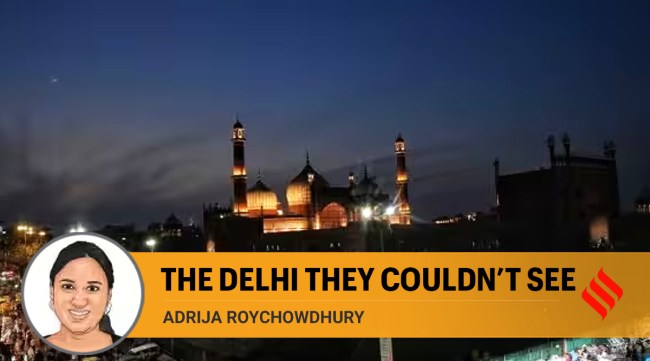Opinion G20 beyond the Summit: The Delhi that world leaders could not see
From the Old City and the modernist architecture of newly independent India to the Yamuna – there is much that the G20 leaders missed out on. And what we show visitors reflects what we are proud of
 A view of the Jama Masjid in Old Delhi. (Express file photo by Abhinav Saha)
A view of the Jama Masjid in Old Delhi. (Express file photo by Abhinav Saha) For the foreign eyes, to see the capital is one thing, to be shown around is quite another. The curated display of a capital for international visitors is all the more complex when it comes to a city like Delhi, which has, for centuries, been the centre of state power to multiple dynasties and empires. Their memories and remnants often overlap, and are spread all over the city, sometimes in the most unsuspecting of spaces. Which among them one chooses to show and what is ignored or left out for a different time becomes a matter of deciding what in the capital most reflects the idea of the India one is proud of.
Reports suggest that the G20 delegates would be making stops at Rajghat, the National Gallery of Modern Art (NGMA) and Pusa Agriculture Institute, among others that are yet to be disclosed for security reasons.
One wonders, though, what in Delhi would be missed out or even hidden from the international heads of state. It would be a pity, for instance, if one were to not visit the oldest city of Delhi, Mehrauli. Since the 11th century, Delhi has been a popular choice as the capital for several dynasties, thereby giving rise to the notion of seven cities of Delhi (although some say it was nine or 14). Mehrauli was where it all began. From the Tomar Rajputs, right up till the British rule, Mehrauli has seen continuous habitation and urban activity since the eighth century. Apart from being the centre of state power, Mehrauli village also thrived as a spiritual centre, a trading post, a wholesaler’s market, and is today a favourite destination for exquisite boutiques.
Follow our G20 live blog for the latest updates!
The Qutub Complex in Mehrauli, which is also a UNESCO world heritage site, and gets its name from the 12th-century minaret built by Qutubuddin Aibak and Iltutmish, almost always makes its way into the itineraries of visitors to Delhi. However, despite being situated right next to it, the Mehrauli Archaeological Park, spread out over 200 acres and housing more than a hundred monuments, is often missing from the tourist map of Delhi. Layers of Delhi’s history come alive inside the park with monuments dating all the way back to the 11th-century Sultanate rule sitting alongside Mughal monuments (Tomb of Adham Khan, Jharna) and 19th-century additions made by the British (summer palace of Sir Thomas Metcalf).
The Mughal capital of Shahjahanabad, better known as Old Delhi or by the misnomer Chandni Chowk, is another intrinsic part of the city that is most often kept hidden from visiting foreign delegations. The narrow, chaotic lanes, frequently considered a security risk for high-ranking political visitors, is in fact where the spirit of Delhi is most alive. There is no pattern to the way streets emerge here. The chaos of this erstwhile Mughal city is symptomatic of the democratic and free-spirited ways in which neighbourhoods, markets, streets and cul de sacs have thrived blissfully for years.
Be it the food, the language of its residents, the ornate havelis (albeit very few of these still exist), or the unique street names that have remained mostly untouched by the British and the authorities of post-Independence India, Old Delhi is one place where one can find the heritage of 18th and 19th century Delhi, living, breathing and thriving. Old Delhi is also where one can boast of the spirit of diversity and secularism that India is most proud of. Mosques such as Jama Masjid and Fatehpuri Masjid stand peacefully in close quarters to the Gauri Shankar Temple dedicated to Lord Shiva and the Digambar Jain Lal Mandir. The Central Baptist Church and the Gurudwara Sis Ganj stand opposite each other on the same street, representing peaceful coexistence that has remained unaffected by the winds of political changes in the capital.
One can expect foreign delegations of the nature of G20 visitation to be housed in and touring around the most modern and chic parts of the city. One can hope that they will be introduced to the spirit of post-Independence architecture, examples of which dot the same streets. Emerging out of a long anti-colonial struggle, Delhi after 1947 was built with a forward-looking vision, of the kind one can only expect from a post-colonised country. Institutions and buildings such as the Sahitya Akademi, the India International Centre, the Shri Ram Centre of Performing Arts are just a few examples of architecture that tell a story of an aspirational new country that strove to shrug off its past misfortunes and stand tall amidst the more progressive nations of the world. It is unfortunate that one of the best examples of this architecture, the Hall of Nations, a state-of-the-art exhibition hall designed by the architect Raj Rewal and inaugurated in 1972 to mark the 25th Independence Day, has already been demolished.
A special characteristic of Delhi is the city’s ability to draw migrants from across the country and the world. A visitor to New York might well be advised to not miss out on its famous Chinatown. In Delhi, enclaves where the “outsider’” identities are preserved and celebrated in their food, festivals and cultural institutions, rarely make their way to the itinerary of foreign delegations. The Tibetan settlement at Majnu ka Tila, the Afghan colony in Lajpat Nagar, and the mini Bengal settled in Chittaranjan Park, among many others give a unique colour to the city.
And finally, there’s the river. There is a crucial space and role that water bodies fulfil in every major city of the world. It is unthinkable for one to visit London and not take a stroll around the Thames, or for visitors in Paris to not see the Seine. In Delhi though, the Yamuna’s relationship with its own residents lie forgotten in receding water levels, increasing pollution and excessive urbanisation. In its current avatar, it can hardly be expected of foreign delegates to engage with what was once the lifeline of the city, and one of the most vital factors behind why Delhi became the centre of empires for generations.
adrija.roychowdhury@indianexpress.com



